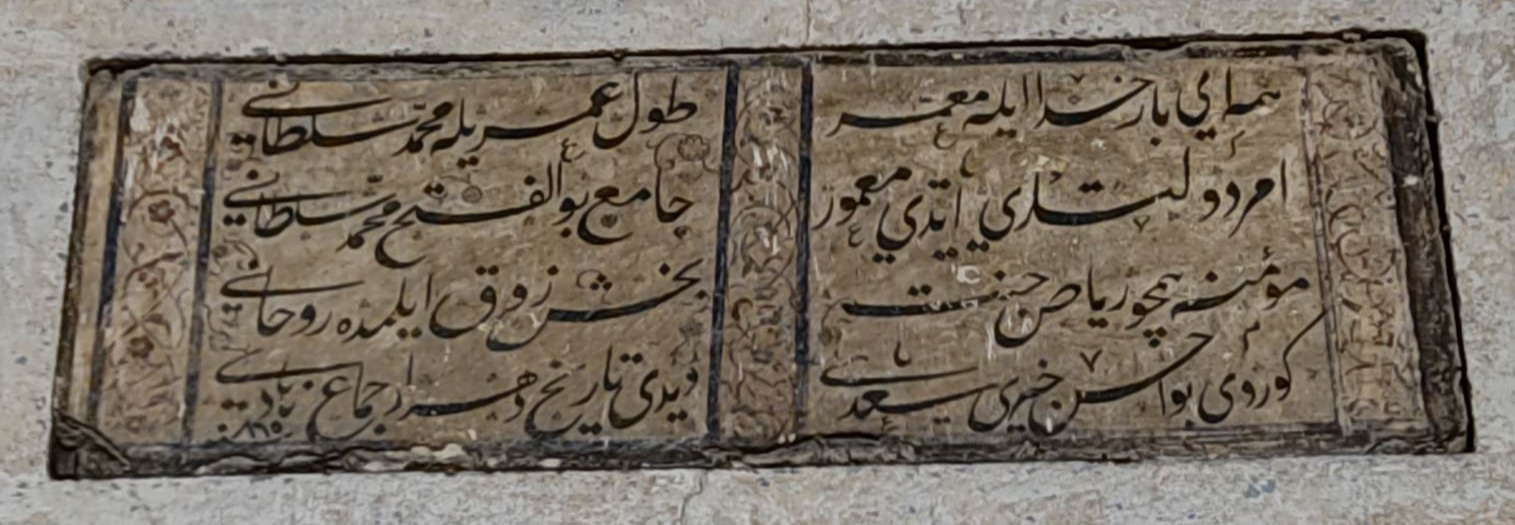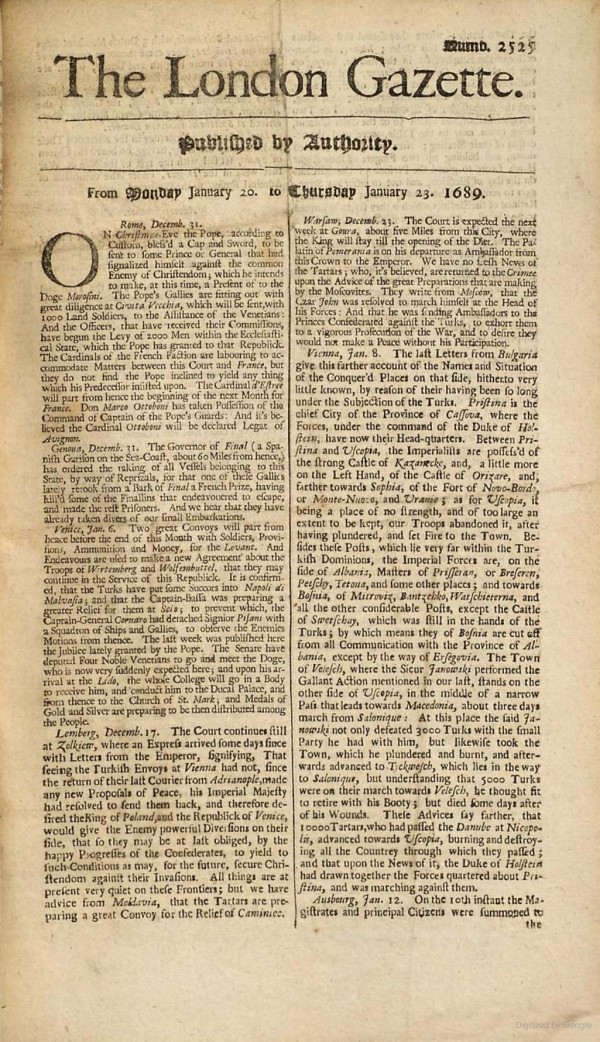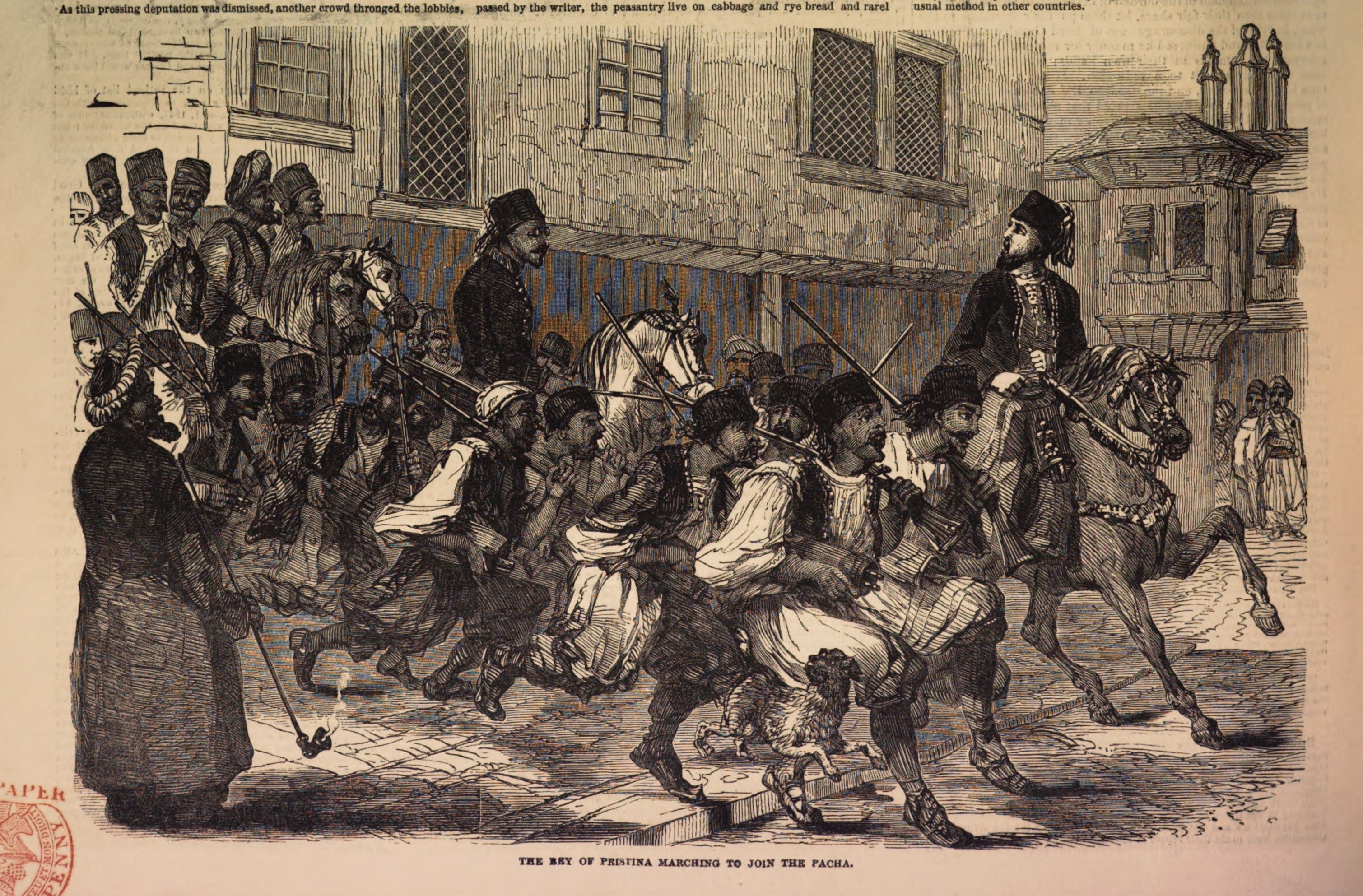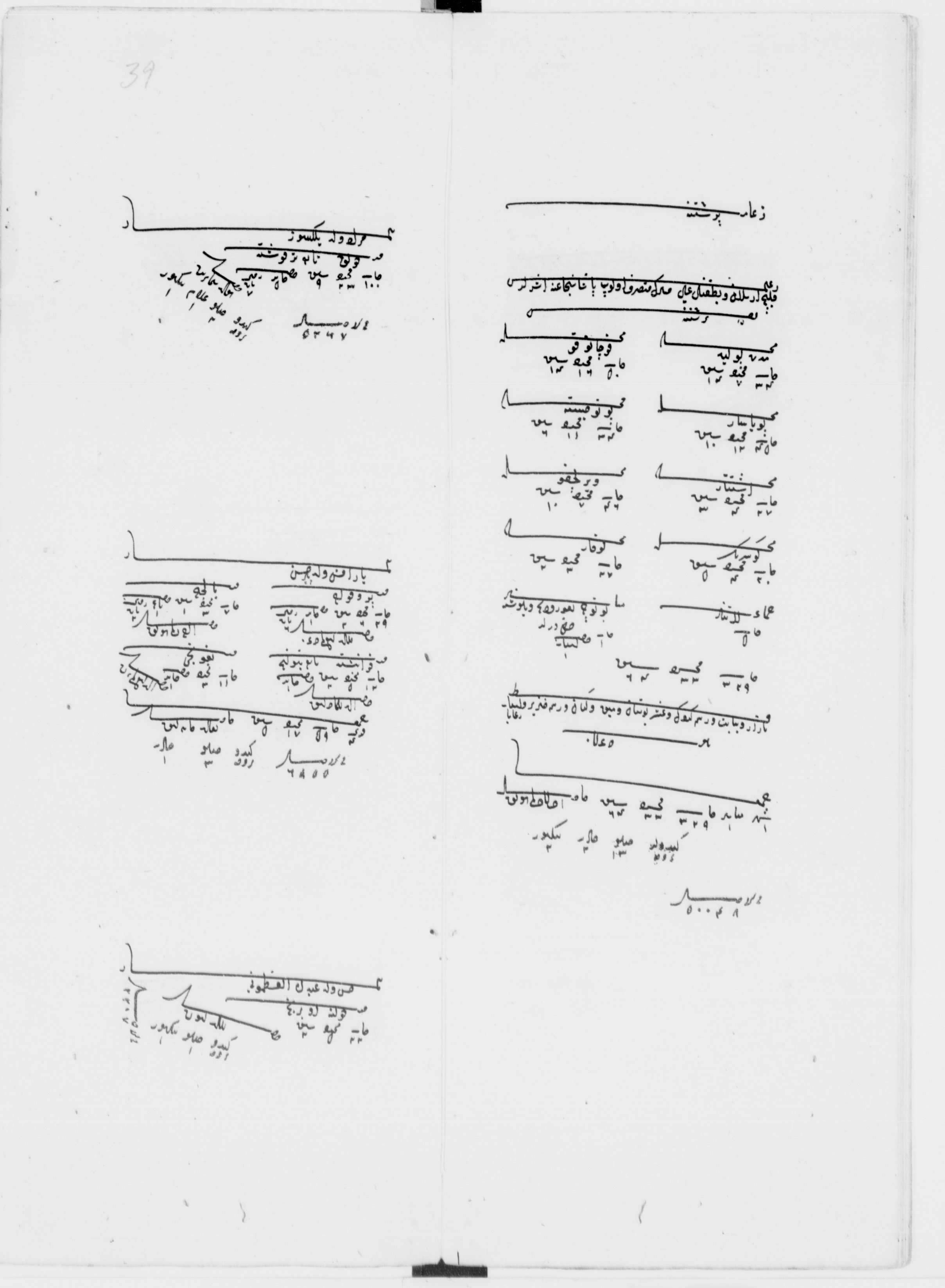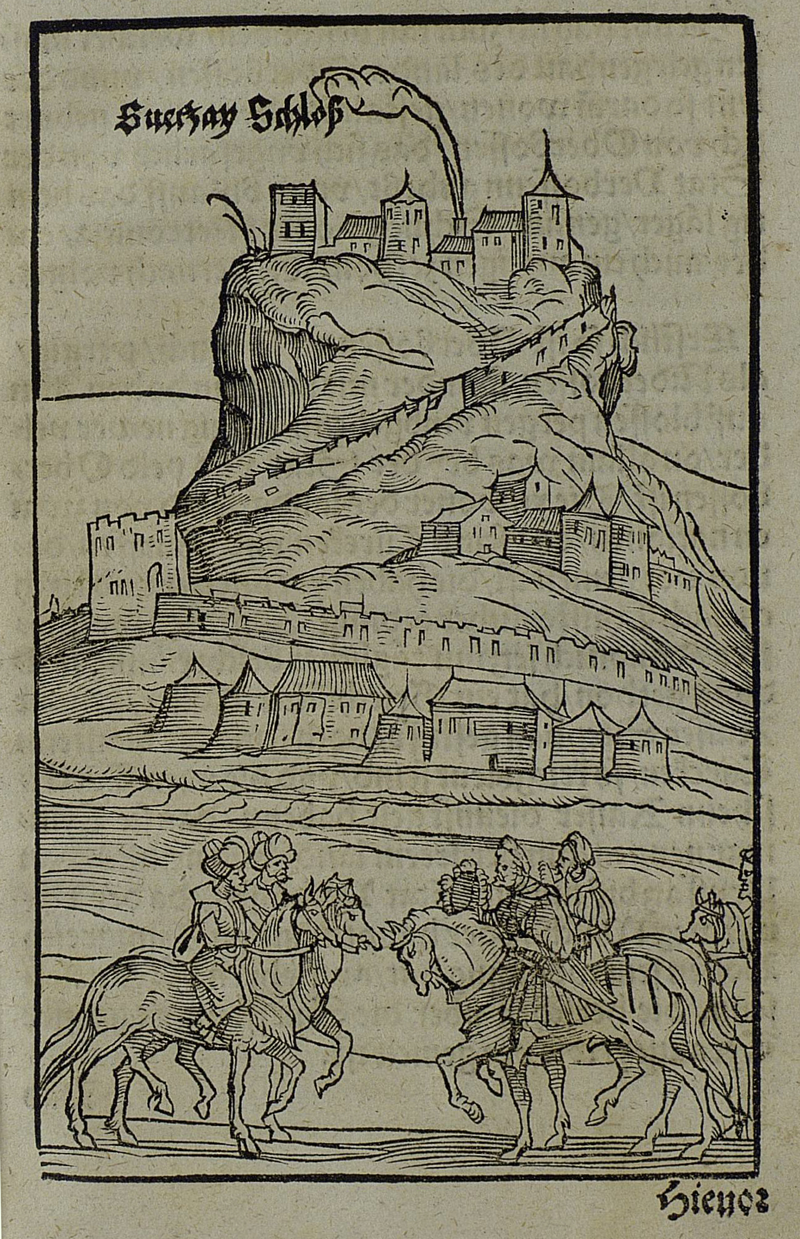After the death of King S. Dushan (1355), and the dissolution of the medieval Serbian state of Rashka, Pristina became one of the seats of Vuk Branković and his successors. With the Ottoman victory in the Battle of Marica (1371), from time to time groups of akingi*1 Ottomans would organize attacks against Pristina, which at that time was the capital of the region.2 After the First Battle of Kosovo (1389), this part of ancient Dardania became subject to Ottoman vassalage and Prishtina began being administered by Ottoman officials (albeit with secession), as is the case with Gazi Isa Beu, who was the master of Pristina until the year 1446.3 He held this position two years later (1448) as well, which coincides with the year when the second Battle of Kosovo took place, and Skender Turku (Sxhander Turcho) is mentioned as the ruler of Pristina.4
When Sultan Mehmet II, (nicknamed Fatih 'conqueror' according to his opponents, 'slaughterer' according to Ottoman subjects), put an end to the Byzantine Empire (May 1453), in June 1455, he launched a military attack on the mining areas of territory of Kosovo, which resulted in the complete subjugation of Novobërda, Trepça, Pllana and Zapllana. In the end, he took full control of the entire plain of Kosovo, establishing the vilayet of Vëlk, then the sanjak of Vilčiterina (Vushtrri), which was formed by Prishtina, Novobërda and Trepça.5 The sanjak which, until the establishment of the vilayet of Kosovo, was depending on the Eyalet of Rumelia.6 *
After about 300 years under Ottoman rule, the territory of Kosovo was conquered by the armies of the Holy League. The latter, after taking Belgrade and Nish by war, in September 1689, from the territory of (today's) middle Serbia, penetrated into Jenipazar (today's Novipazar), where they repulsed the army led by Mahmud Pasha Begolli of Peja. A month later (in October), Prishtina, together with Novoberda and Kaçanik, fell under the control of the Habsburg army, led by Piccolomini. The fall of the city caused a good part of the Muslim inhabitants to abandon the city and migrate to safer places. A large number of complaints from citizens of the Islamic faith in Prishtina, Novobërda, Vushtrri, Morava (the territory of today's Gjilan) and Janjeva indicate that during this time, when Kosovo was under the new occupation of the Habsburgs, they were initially moved from their lands, and had managed to return only after the restoration of Ottoman rule in this territory. The document below, signed by the heads of these cities, gives this information.
"Ylemaja, the Salihs (the wise) and the humble (ordinary citizens A.I.) from Pristina, Kosovo, all together in the Sharia court have stated that, from the previous invasion of the infidels (the army of the Holy League A.I.), they were we destroyed and together with our families, we moved to other countries. While we were separated in different countries, in the name of God our Province (A.I. homeland) was liberated and after it joined the liberated Islamic lands, with the exalted ferman we returned to our countries empty-handed. Valuable things were sold, or we borrowed money, and with it we bought seeds and oxen. (Thus A.I.) For a year or two, we were engaged in agriculture and thus facing poverty, our Vilayet was again attacked by 2,000 thieves and gangs. (On this occasion A. I.) some of us were captured and some fell martyrs, (they) burned our houses and took away all kinds of cattle that we had in hand. All the mahallas are in a deplorable condition. We lost everything we had. We have informed the Supreme State (Osman A. I.) about our situation, which has mercy and creates security conditions in our country..., For two years there has been drought and great cost in our city, (even) we are constrained because the grains and we get food from other places. Our situation is also difficult because of thieves and gangs who are attacking this year as well. Therefore, we ask that you respond to our requests, to send special people to create security in our city. With your permission, taking into account our difficult situation and also since we are entering the holy month of Ramadan, these days, Fermani High has arrived, for the gathering of 12,000 kilograms of mixed grains according to the measurement of Istanbul , which will be collected from Skopje and Kosovo. It is difficult for your poor slaves, who are needed for a metelic, to collect so much grain and cattle to carry. However, we do not go against the firman (imperial order A. I.), on the contrary, we ask for your mercy to free us from these heavy taxes. the decision belongs to the righteous and forgiving (Sultan A.I.). Date 27 May 1695. Mustafa."
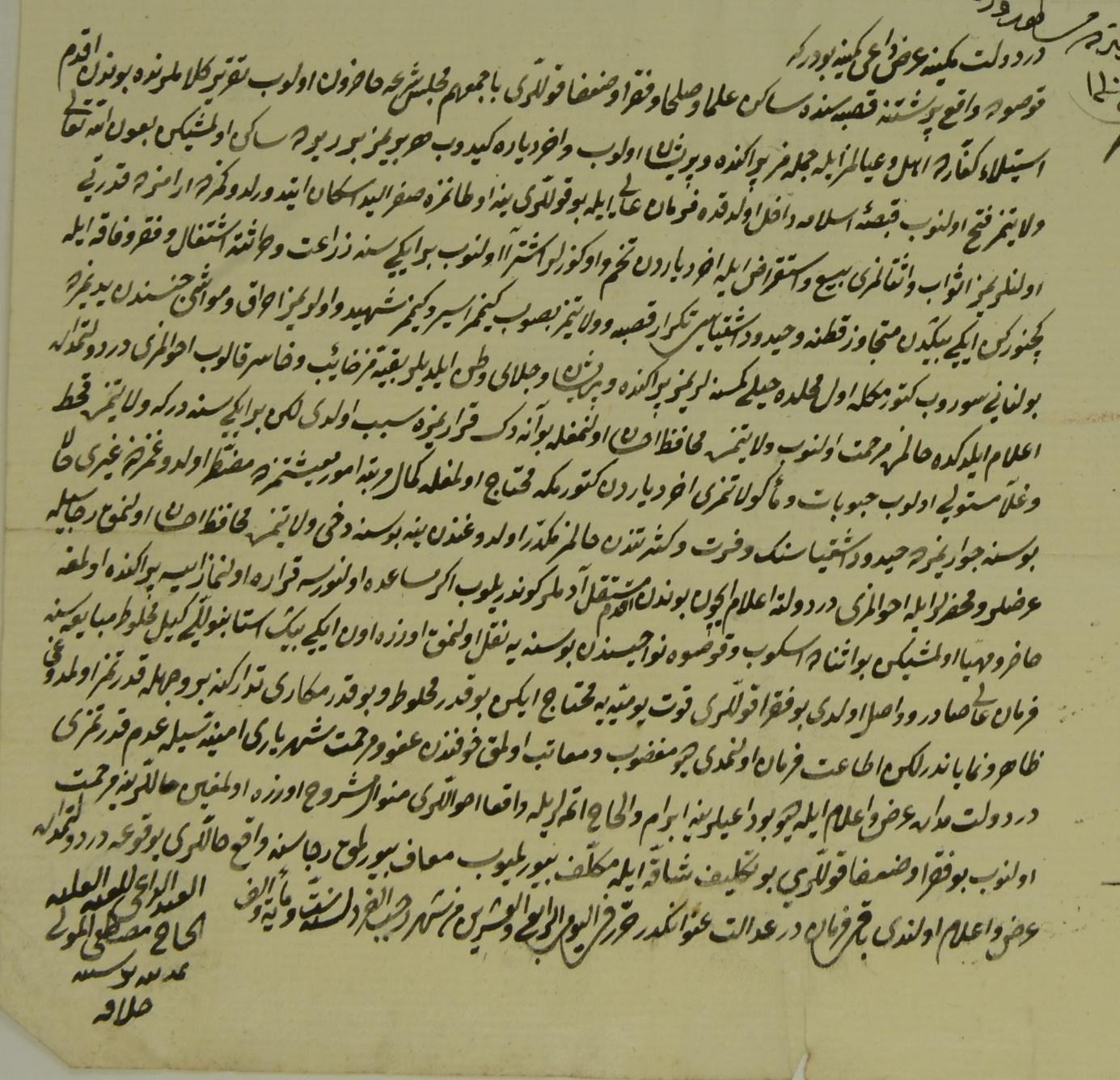 The letter of May 27, 1695 is in digital copy in the Archive of Pristina.
The letter of May 27, 1695 is in digital copy in the Archive of Pristina.
After the conquest of Kosovo, Picolomini followed Mahmud Pasha Begolli to Skopje, and after burning the city, he retreated back to Kosovo.7
Piccolomini, who during the annexation of Kosovo found the support of the Catholic and Orthodox religious clergy,8 three days after entering Prizren, died of the plague (November 9, 1689) and his burial ritual was performed by Pjetër Bogdani, who had hosted him during the march to Prizren. A month later, in Prishtina, the latter (P. Bogdani) died as well, also from the plague, and was first buried in the courtyard of the Great Mosque, nicknamed the Mosque of Fatihu (Sultan Mehmed II) in this city, which at the time of the occupation by the armies of the Holy League, was transformed into a cathedral by the Habsburg officials (part of the Holy League), as a sign of the dominance of the Habsburgs against the followers of Sultan Mehmed II, who was considered the greatest enemy of the Christian world (since Sultan Mehmet had dissolved the Byzantine Empire, turning the cathedral of Saint Sophia (Aya Sofia) in Constantinople into a mosque).9
Against the Habsburgs, the Sultan sent Serasqer of Morea, Halil Pasha (nicknamed Koxha) with his army and 3,000 Albanians, who were at the time in Skopje. These, together with the large Tatar forces, after crossing Skopje and Kaçanik, forced the enemy army to abandon Kosovo and thus managed to restore Ottoman power (January 1, 1690) in these territories, which had been administered by them since 1455.10 On this occasion, the Ottoman officials exhumed Pjetër Bogdani from the courtyard of the Great Mosque of Pristina, just as they condemned the collaborators of the Holy League army.
38 years after the agreement of Karlovac (1699), the Habsburgs tried again to extend to the Ottoman lands of Rumelia. Thus, after taking the city of Nish, in 1737, they advanced towards the south and went down to Sehirkoj (Pirot), marching towards the territory of Kosovo. However, before reaching the latter, they were repulsed by Hasan Bey, the son of Mahmud Pasha Begolli, mytesarrif of Ohrid and Prizren.11 However, the documents of the time recorded another violent migration of the majority of the population (Muslims) from the Kosovo Plain, which had come as a result of the cooperation of the Austrian policy of the time with the Christian religious authorities (the Orthodox patriarch Arseni and the Catholic archbishop of Tivar, Mëhill Suma), who had encouraged the Orthodox and Catholic Albanian tribes of Kelmend, Kuç, Hot, Grudë, Bratonović and Vasojević to stand up against the Ottoman state. However, within 10 days, a military force of 1,500 soldiers under the command of the beylerbey of Rumelia managed to suppress the uprising in question.12
***
After the Tanzimat period, within the framework of the administrative reforms that came as a result of the Ottoman-Russian agreement of Saint Stefan (March 3, 1878) and the Congress of Berlin, in 1877-1878 the Province of Kosovo was founded with Prishtina as its center.13 Considering that the Congress of Berlin formaly recognized some articles of the Russo-Ottoman agreement that foresaw the fragmentation of Albanian lands, the Albanian elite founded the Albanian League of Prizren (on June 10, 1878) which adopted the political program that called for the independence and unification of the Albanian vilayets (Kosovo , Manastir, Janine, Shkodër) in a single administrative unit. This Albanian political body was so advanced that it even had its own military wing that protected their lands. Thus, in January 1881, the forces of the Albanian League of Prizren, led by Haxhi Sylejman aga (Vokshi), marched towards Skopje and the center of the Kosovo Province, Prishtina, which they took under administration and for two years in a row these cities were part of the lands liberated from the Ottomans; where taxes were also collected for the benefit of the coffers of the government of the League of Prizren.14
-
1
*attacking force, forerunners of the Ottoman army.
-
2
Michel Kiel, "Priştine", Dianet İslam Ansiklopedisi, İstanbul 2007, p. 346.
-
3
Skender Rizaj, "Kosovo During the XV, XVI and XVII Centuries: Administration, Economy, Society and Popular Movement", Pristina: Rilindja, 1982, 244, Selahatin Tansel, Osmanli Kaynaklarina gore Fatih Sultan Mehmed'in Siyasi ve Askeri Faaliyetleri, Ankara: Türk Tarih Kurumu, 1999, p. 114.
-
4
S. Rizaj, ibid.
-
5
Nikolai Todorov, The Balkan City (1400-1900), London: University of Washington Press, 1983, fq. 26.
-
6
Ejalet was the largest administrative unit of the Ottoman administration. While Rumelia all the spaces of the Balkans and the peninsula.
-
7
Nuri Bedzeti (Bexheti), "Die Teilhänge Albaner am "Groben Türkenkrieg 1683-99", [Doctoral Dissertation], Universitat Wien, Vienna 2005, p. 119.
-
8
Ferit Duka, "Albania during the Ottoman rule (a short history)", Ottoman centuries in the Albanian space (Studies and Documents), Tirana: UET Press, 2009, p. 382
-
9
Odette Marquet, Pjetër Bogdani: Letters and Documents from the Archive of the Congregation "de Propaganda Fide" as well as from the Secret Archives of the Vatican, Shkodër 1997, p. 508–509.
-
10
Malcolm, Kosovo: a short history, [Translated by: Abdullah Karjagdiu] Prishtina: Koha, 2001, pg. 157–158.
-
11
BOA. AE. SMHD. II.130/9527.
-
12
Stavri N. Naçi, The Patriarch of Shkodra under the rule of the Bushatlli (1757-1796), Tirana: State University of Tirana, Institute of History and Linguistics, 1964, p. 48.
-
13
According to the researcher prof. Skender Rizaj, the Vilayet of Kosovo which consisted of Sofia, Nishi and Prishtina was founded before the Ottoman-Russian war and after the agreement of Saint Stefan, Pristina became the center of the Vilayet. See. Iskender Rizay, "Kosova Viljati Teşkilâtı", VII. Türk Tarih Kongresi, c. II, Ankara: TTK. Basımevi, 1973, p. 666.
-
14
1916 | Theodor Ippen: Nineteenth-Century Albanian History, access: 25.12.2023; see also Iljaz Rexha, League of Prizren in Ottoman documents, Pristina: Kosovo Archive, 1978.

